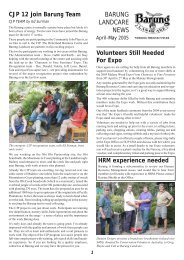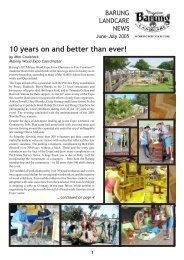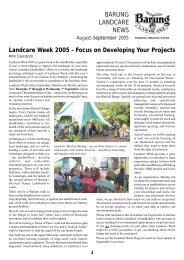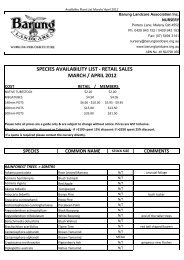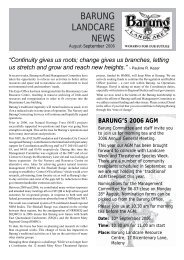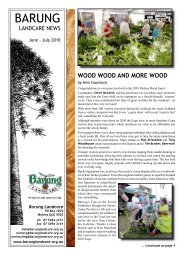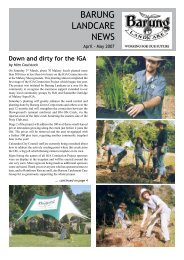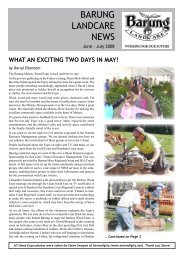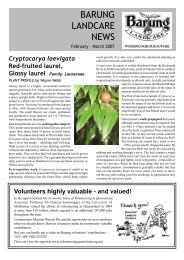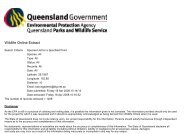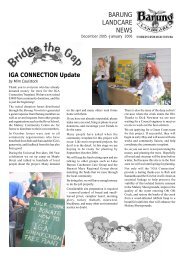June/July 2012 - Barung Landcare
June/July 2012 - Barung Landcare
June/July 2012 - Barung Landcare
You also want an ePaper? Increase the reach of your titles
YUMPU automatically turns print PDFs into web optimized ePapers that Google loves.
AUSTRALIAN BRUSH-TURKEY<br />
RAINFOREST BIRDS OF THE BLACKALL RANGE by Eric Anderson<br />
Brush- or scrub turkeys are large black fowl with<br />
prominent tails that are flattened sideways. They<br />
have bare red-skinned heads and necks with bright<br />
yellow wattles. Males and females are of similar size.<br />
The male’s heads and wattles become much brighter<br />
during the breeding and nesting season. The underside<br />
of the body is sprinkled with white feathers, which are<br />
more pronounced in older birds. Chicks do not look<br />
much like their parents, being small, plump birds with<br />
rich brown feathers. They grow fast, and within a few<br />
months a chick will have the dull blue-black plumage<br />
and the characteristic upright tail of the adult. Its head<br />
and neck will have become a featherless rich pink.<br />
Brush-turkeys are large ground-living birds but fly<br />
heavily up into trees, with flapping leaps to roost and<br />
to escape danger. The voice is a variety of harsh deep<br />
grunts and loud clucks. Males have a deep three-noted<br />
booming call.<br />
The Brush-turkey’s range extends along eastern Australia, from<br />
Cape York Peninsula south to the Illawarra region of New South<br />
Wales. They are most common in coastal districts but also in<br />
adjacent highlands, inhabiting rainforests and wet sclerophyll<br />
forests, but can also be found in drier scrubs west of the Dividing<br />
Range. They feed mainly on small reptiles, amphibians, insects,<br />
seeds and fallen fruits, which are exposed by raking the leaf litter<br />
or breaking open rotten logs with their large feet.<br />
In Queensland they breed mainly from May to November. Their<br />
nest is a mound up to 4 m in diameter and 1.5 m high and constructed<br />
with leaves, other organic material and earth. Some 12<br />
to16 pure white, long-oval eggs, 91 by 64 mm, are laid in holes<br />
in the mound. The male regulates the temperature in the 33 to<br />
35C range. Incubation takes about 7 weeks, after which the young<br />
dig unaided to the surface and immediately begin fending for<br />
themselves. Perhaps because of this, the mortality rate for brush<br />
turkey chicks is high, with only about one in 200 chicks surviving<br />
to adulthood.<br />
Brush-turkey eggs are a favourite food of goannas, snakes, dingos<br />
and dogs and once were a staple of Aboriginal Australians. Often<br />
goannas exhibit wounds on their tails, having been pecked by<br />
Brush-turkeys who ferociously chase them away from their nests.<br />
In situations where Brush-turkeys come into contact with humans,<br />
such as in picnic areas in national parks, they exhibit little fear<br />
and will often boldly attempt to steal food from tables.<br />
BARUNG THANKS ITS EXPO<br />
VOLLIES<br />
Eric Anderson and his tireless<br />
Board cohort thanked this year’s<br />
Wood Expo vollies for their cheerful<br />
and dedicated efforts towards<br />
producing a successful outcome<br />
to our showcase fundraiser by<br />
putting on a barbie down at Lake<br />
Baroon in glorious sunshine. The<br />
heartfelt thanks were appreciated<br />
all-round and we are all looking<br />
forward to next year.<br />
Male Australian Brush-turkey.<br />
[Photo: Eric Anderson]<br />
Brush-turkeys will nest in suburban gardens, and in search of<br />
material for their nests will patiently remove enormous amounts<br />
of mulch from neighbouring gardens. A standard garden can be<br />
stripped by a mound-building male Brush-turkey in less than a<br />
day. Once a male Brush-turkey has started to build its mound,<br />
it is extremely difficult to prevent it from continuing its efforts.<br />
If you disturb or move the mound during the day, the male will<br />
probably rebuild it in the same location the next day, persisting<br />
until the end of the breeding season.<br />
No single method of deterrence has proved effective in all situations,<br />
but you can try spreading a heavy tarpaulin over the mound<br />
and weighing it down, to prevent the bird from working. Also,<br />
try diverting the bird’s attention to a less attractive or valuable<br />
area of your garden by building a household compost mound.<br />
Ideally, this compost mound should be sited next to at least one<br />
large tree providing 80 to 95 per cent shade. The Brush-turkey<br />
may be attracted towards the area, and may eventually take over<br />
the compost mound as its nesting mound. For further ideas on<br />
how make your garden more Brush-turkey-proof refer to the<br />
DERM website:<br />
www.derm.qld.gov.au/wildlife-ecosystems/wildlife/<br />
living_with_wildlife/brushturkey.html<br />
CARING FOR WILDLIFE<br />
For information on rescuing,<br />
rearing, rehabilitating and releasing<br />
native animals back to the wild,<br />
check out the WILVOs (Wildlife Volunteers<br />
Association) website on<br />
www.wilvos.org.au<br />
or phone the hotline (07) 5441 6200.<br />
BIOCONTROLS FOR VINE WEEDS<br />
Biocontrol agents are now available that are active against Cat’s<br />
Claw Creeper and Madeira Vine. See article on page 10 of the new<br />
CodLine (Issue 23) at www.mrccc.org.au/newsletters.html<br />
Contact the Mary River Catchment Coordinating Committee for<br />
more information on mrccc@ozwide.net.au or 5482 4766<br />
11



